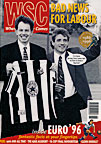 Up until the mid-1970's Ajax were just one of four first division clubs in Amsterdam. Karel Stokkermans explains what happened to their local rivals
Up until the mid-1970's Ajax were just one of four first division clubs in Amsterdam. Karel Stokkermans explains what happened to their local rivals
It is over a decade ago since Ajax last played a match against local opposition – a second round cup tie in December 1983 against the amateurs of DWV, which they won 6-0.The last league derby in Amsterdam was nearly two decades ago: on March 19th, 1978, when Ajax beat FC Amsterdam 5-1.
Today, Ajax is the only surviving professional club in Holland’s biggest city, while Rotterdam has three (Feyernoord and Sparta in the first division, Excelsior in the second) and even Eindhoven (population 200,000) is able to sustain two professional outfits. A far cry from 1961-62, when Amsterdam boasted no less than four teams at top level. Ten years on, the ‘other’ three were to merge, as FC Amsterdam, playing in the Olympic Stadium.
FC Amsterdam were not the first club to die unnoticed at that venue. The very same had happened to Blauw Wit, tenants at the Stadium from 1928 and for a long time the main city rivals of Ajax (they won 7 district titles in the days when the Dutch championship was decided by playoffs between regional champions). They were in decline by the time that professional football was introduced in 1954, however, and were midtable in the second division when FC Amsterdam was created.
De Volewijckers had been wartime champions but played just two seasons at the top level, and set several records in the last – including their final total of 8 points. When FC Amsterdam were formed, they were bottom of the second division. After two more years of that, they gave up and joined the merger.
By the mid 1950s Ajax’s fiercest local rivals were DWS (‘Door Wilskracht Sterk’ – ‘Strong By Willpower’), originally from the working class Spaarndammerbuurt district, and popularly seen as the ‘people’s team’. They had won five district titles in the amateur days, but in 1956 had failed to qualify for the inaugural first division.
They bought their way in two years later through acquiring the playing licence of the short-lived bvc Amsterdam (‘bvc’ abbreviates as ‘professional football club’ in Dutch) who had been formed at the advent of professionalism.
DWS’s first spell at the top ended in relegation in 1962. But then followed the most spectacular rise in Dutch professional football to date: promotion in 1963, the championship for the first (and only) time the year after, then a narrow defeat in the European Cup Quarter Finals the following year.
Flushed with success, the directors decided that DWS should go fully professional – the first Dutch club to do so (most players up that point had been only semi-pro). But though the squad contained half a dozen players with international experience, they failed to meet expectations. Even worse, thanks to a good coach, Rinus Michels, and some luck in collecting an exceptional group of young players, Ajax suddenly rose from obscurity to European stardom, overshadowing all local rivals.
DWS kept producing quality players (World Cup keepers Jan Jongbloed and Piet Schrijvers started their careers there, as did national team striker Rob Rensenbrink), but they stared relegation in the face annually, until the merger with Blauw Wit to form FC Amsterdam in 1972. (DWS, Blauw Wit and their third partner De Volewijckers continued to exist as amateur clubs playing at regional level, where they thrive to this day. DWS youth team graduates include Johnny Metgod, Ruud Gullit and Frank Rijkaard.)
FC Amsterdam made a promising start, reaching the UEFA Cup Quarter Finals in 1974-75 a run that included an away win against Inter Milan. Sadly, the club was soon scarred by infighting and mismanagement, leading to surging debts and plummeting attendances (Ajax and DWS had comparable gates until the late Sixties, but FC Amsterdam was never popular with fans of the old clubs who transferred allegiance to the amateur teams).
With crowds down to less than 2,000, lost in the vast Olympic Stadium, the club’s league games were switched to the stadium’s training pitch. The best players had to be sold, relegation followed in 1978, and just four years later the club was closed down completely after the collapse of a proposed move to Almere, a new satellite town of Amsterdam, built on land reclaimed from the sea. Today there are hopes of setting up a new professional club there, but its name doesn’t bode well: De Zwarte Schapen – ‘The Black Sheep’. . .
From WSC 112 June 1996. What was happening this month